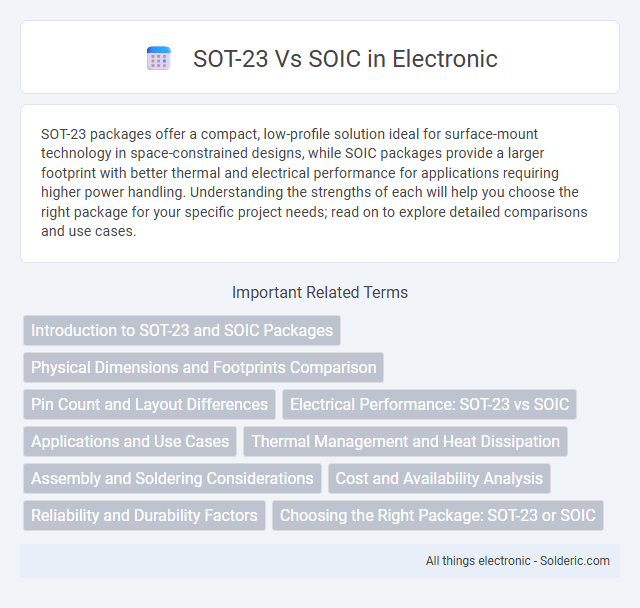SOT-23 packages offer a compact, low-profile solution ideal for surface-mount technology in space-constrained designs, while SOIC packages provide a larger footprint with better thermal and electrical performance for applications requiring higher power handling. Understanding the strengths of each will help you choose the right package for your specific project needs; read on to explore detailed comparisons and use cases.
Comparison Table
| Feature | SOT-23 | SOIC |
|---|---|---|
| Package Type | Small Outline Transistor | Small Outline Integrated Circuit |
| Body Size | Approx. 2.9mm x 1.3mm | Varies, typically 3.9mm to 10.3mm width |
| Pin Count | 3 pins | Typically 8 to 28 pins |
| Mounting | Surface-mount device (SMD) | Surface-mount device (SMD) |
| Typical Use | Discrete transistors, small components | ICs, amplifiers, logic devices |
| Package Height | Approx. 1.3mm | Approx. 1.5mm |
| Thermal Performance | Lower power dissipation | Better heat dissipation due to larger size |
Introduction to SOT-23 and SOIC Packages
SOT-23 and SOIC are common surface-mount packaging types used in electronics for housing semiconductor devices. SOT-23 packages are small, three-lead components typically used for transistors and diodes, favored for space-constrained circuit designs. SOIC packages, offering more pins and larger footprints, accommodate integrated circuits requiring higher pin counts and improved thermal performance.
Physical Dimensions and Footprints Comparison
The SOT-23 package features a compact outline measuring approximately 2.9 mm by 1.3 mm, designed for space-constrained PCB layouts, while the SOIC package typically spans around 8.6 mm by 3.9 mm, offering a larger footprint suitable for standard surface-mount applications. The SOT-23's smaller size and three-pin configuration make it ideal for high-density circuit designs, whereas the SOIC provides 8 to 28 pins arranged in two parallel rows, supporting more complex integrated circuits. PCB footprint designs for SOT-23 require minimal pad area and simplified routing, contrasting with the SOIC's wider pad spacing and dual-row pin arrangement demanding more PCB real estate.
Pin Count and Layout Differences
SOT-23 packages typically have 3 to 6 pins arranged in a compact, triangular layout optimized for minimal PCB space, while SOIC packages feature a wider range of pins, commonly 8 to 28, arranged in two parallel rows suitable for more complex circuits. The SOT-23's smaller footprint and lead spacing make it ideal for surface-mount applications requiring low pin counts and compact design. SOIC's dual-inline pin configuration facilitates easier soldering and testing in medium-pin-count applications, providing better mechanical stability on PCBs.
Electrical Performance: SOT-23 vs SOIC
SOT-23 packages offer lower parasitic capacitance and inductance due to their smaller size and shorter lead lengths, enhancing high-frequency electrical performance compared to SOIC packages. SOIC, with larger leads and body size, typically exhibits higher thermal resistance and greater parasitic effects, impacting signal integrity in high-speed circuits. Design engineers select SOT-23 for compact, high-frequency applications while SOIC remains favorable for ease of handling and moderate-frequency uses.
Applications and Use Cases
SOT-23 packages are ideal for compact, high-density circuit designs in mobile devices, wearables, and IoT applications due to their small size and low power consumption. SOIC packages suit applications requiring easier manual soldering and inspection, such as prototyping, automotive electronics, and industrial control systems. Your choice depends on the balance between space constraints and assembly considerations in your project.
Thermal Management and Heat Dissipation
SOT-23 packages exhibit limited thermal management due to their small size and reduced surface area, resulting in lower heat dissipation capacity compared to SOIC packages. SOIC packages provide improved thermal performance with larger leads and exposed pads that enhance heat transfer to the PCB. You should consider SOIC for applications requiring efficient heat dissipation and higher power handling.
Assembly and Soldering Considerations
SOT-23 packages feature a compact, three-pin design ideal for high-density circuit boards, requiring precision in pick-and-place automation and reflow soldering for proper heat control. SOIC packages, with their larger size and gull-wing leads, allow for easier manual soldering and inspection but demand careful thermal profiling to prevent lead damage during wave or reflow soldering. Your assembly process must account for these differences to ensure reliable solder joints and optimal electrical performance.
Cost and Availability Analysis
SOT-23 packages typically offer lower costs due to their smaller size and widespread use in compact consumer electronics, resulting in high availability from multiple suppliers. SOIC packages, while generally more expensive, provide easier manual handling and stronger mechanical robustness, often preferred for prototyping and through-hole compatible applications. Your choice depends on balancing budget constraints with assembly preferences, as SOT-23 is more cost-effective and widely stocked, whereas SOIC offers better accessibility for manual soldering environments.
Reliability and Durability Factors
SOT-23 packages exhibit superior durability in high-vibration environments due to their smaller size and shorter lead lengths, reducing mechanical stress and enhancing reliability in compact, portable electronics. SOIC packages, with larger body and lead configurations, provide better thermal dissipation and are more resilient to mechanical damage during automated soldering processes, improving long-term reliability in robust industrial applications. Both package types require careful consideration of thermal cycling and moisture sensitivity levels to optimize longevity and performance in specific operating conditions.
Choosing the Right Package: SOT-23 or SOIC
Choosing between SOT-23 and SOIC packages depends on your circuit board space and assembly requirements. SOT-23 offers a compact, surface-mount option ideal for high-density designs where board real estate is limited, while SOIC provides easier manual handling and better thermal performance due to its larger size. Your project's size constraints and heat dissipation needs will guide the optimal package selection.
SOT-23 vs SOIC Infographic

 solderic.com
solderic.com